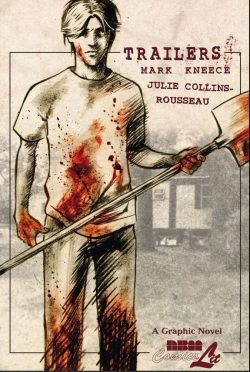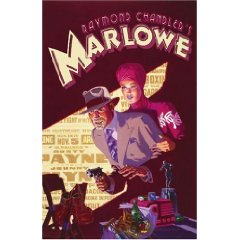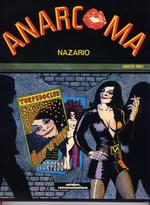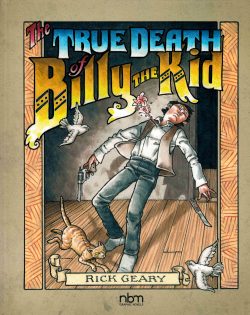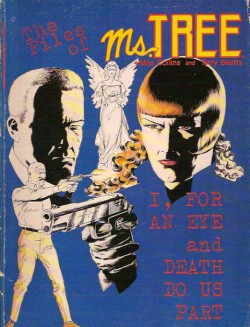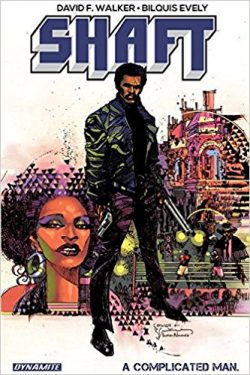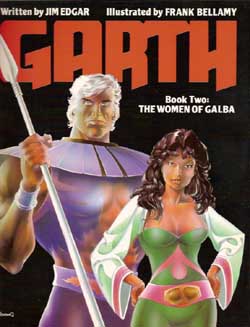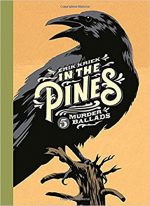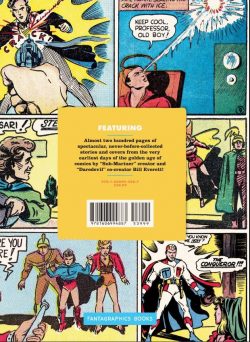
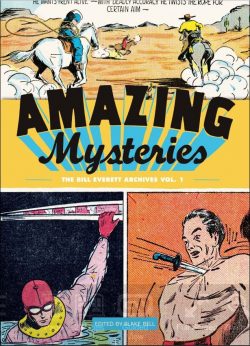
By Bill Everett and others, edited and complied by Blake Bell (Fantagraphics Books)
ISBN: 978-1-60699-488-7
Thanks to modern technology and diligent research by dedicated fans, there is a sublime superabundance of collections featuring the works of too-long ignored founding fathers and lost masters of American comic books. A magnificent case in point is this initial chronicle (available in both print and digital formats) revisiting the incredible gifts and achievements of one of the greatest draughtsmen and yarn-spinners the industry has ever seen.
You could save some time and trouble by simply buying the book now rather than waste your valuable off-hours reading my blather, but since I’m keen to carp on anyway feel free to accompany me as I delineate just why this tome needs to join the books on your “favourites†shelf.
The star of this collection was a direct descendent and namesake of iconoclastic poet and artist William Blake. His tragic life and awe-inspiring body of work – Bill was quite possibly the most technically accomplished artist in US comicbook industry – reveals how a man of privilege and astonishing pedigree was wracked by illness, an addictive personality (especially alcoholism) and sheer bad luck, but nevertheless shaped an art-form and left twin legacies: an incredible body of superlative stories and art, and, more importantly, saved many broken lives by becoming a dedicated mentor for Alcoholics Anonymous in his later years.
William Blake Everett was born in 1917 into a wealthy and prestigious New England family. Bright and precocious, he contracted tuberculosis when he was twelve and was dispatched to arid Arizona to recuperate.
This chain of events began a life-long affair with the cowboy lifestyle: a hard-drinking, chain-smoking, tall-tale-telling breed locked in a hard-to-win war against slow self-destruction. All this and more is far better imparted in the fact-filled, picture-packed Introduction by Blake Bell. It covers the development of the medium in ‘The Golden Age of Comics’, the history of ‘Bill Everett the Man’ and how they came together in ‘Centaur + Funnies Inc. = Marvel Comics #1’.
Th essay also includes an astounding treasure trove of found images and original art including samples from 1940s Sub-Mariner, 1960s Daredevil and 1970s Black Widow amongst many others.
Accompanied by the covers – that’s the case for most of the titles that follow: Everett was fast and slick and knew how to catch a punter’s eye – for Amazing Mystery Funnies volume 1 #1, 2, 3a, 3b and volume 2 #2 (August 1938 – February 1939, Centaur) are a quartet of rousing but muddled interstellar exploits starring sci fi troubleshooter Skyrocket Steele.
These are followed by a brace of anarchic outer space shenanigans starring futuristic wild boy Dirk the Demon from Amazing Mystery Funnies vol. 1 #3a and vol. 2 #3 (November 1938 and March 1939 respectively).
The undisputed star and big draw at Centaur was always Amazing-Man: a Tibetan mystic-trained orphan, adventurer and do-gooder named John Aman. After years of dangerous, painful study the young man was despatched back to civilisation to do good (for a relative given value of “goodâ€)…
Aman stole the show in the monthly Amazing Mystery Comics #5-8 (spanning September to December 1939) as seen in the four breakneck thrillers reprinted here: ‘Origin of Amazing-Man’; an untitled sequel episode with the champion saving a lady rancher from sadistic criminals; ‘Amazing-Man Loose’ (after being framed for various crimes) and a concluding instalment wherein the nomadic hero abandons his quest to capture his evil arch rival ‘The Great Question’ and instead heads for recently invaded France to battle the scourge of Nazism…
As previously stated, Everett was passionately wedded to western themes and for Novelty Press’ Target Comics devised an Arizona-set rootin’ tootin’ cowboy crusader dubbed Bull’s-Eye Bill. Taken from issues #1 and 2 (February and March 1940), ‘On the trail of Travis Trent’ and ‘The Escape of Travis Trent’ find our wholesome but hard-bitten cowpoke battling the meanest and most determined owlhoot in the territory.
Accompanying the strips is an Everett-illustrated prose piece attributed to “Gray Brown†entitled ‘Bullseye Bill Gets his Moniker’.
Thanks to his breakthrough Sub-Mariner sagas, Everett was inextricably linked to water-based action and immensely popular, edgy heroes. That’s why Eastern Comics commissioned him to create human waterspout Bob Blake, Hydroman for their new bimonthly anthology Reg’lar Fellers Heroic Comics.
Here then (spanning issues #1-5; August 1940 to March 1941), are five spectacular, eerily offbeat exploits, encompassing ‘The Origin of Hydroman’ and covering his patriotic mission to make America safe from subversion from “oriental invadersâ€, German saboteurs and assorted ne’er-do-wells. after which a Polar Paladin rears his frozen head.
Sub-Zero Man debuted in Blue Bullet Comics vol. 1 #2 (July 1940): a Venusian scientist stranded on Earth who, through myriad bizarre circumstances, becomes a chilly champion of justice. Everett is only credited with the episode ‘The Power of Professor X’ (from vol. 1 #5, October 1940) but also included here are the cover of vol. 1 #4 and spot illos for the prose stories ‘Sub-Zero’s Adventures on Earth’ and ‘Frozen Ice’ (from Blue Bullet Comics vol. 1 #2 and vol. 2 #3).
The Conqueror was another quickly forsaken Everett creation: a Red, White & Blue patriotic costumed champion debuting in Victory Comics #1 August 1941. Daniel Lyons almost died in a plane crash but was saved by cosmic ray bombardment which granted him astounding mental and physical powers in ‘The Coming of the Conqueror’.
He promptly moved to Europe to “rid the world of Adolf Hitler!†and Everett’s only other contribution was the cover of issue #2 (September 1941).
Accompanied by a page of the original artwork from Reg’lar Fellers Heroic Comics #12 (May 1941), The Music Master details how dying violinist John Wallace is saved by mystic musical means and becomes a sonic-powered superman righting injustices and crushing evil…
Rounding out this cavalcade of forgotten wonders are a selection of covers, spot illustrations and yarns which can only be described as Miscellaneous (1938-1942). These consist of the cover to the 1938 Uncle Joe’s Funnies #1; procedural crime thriller ‘The C-20 Mystery’ from Amazing Mystery Funnies vol. 2 #7 (June 1939) and ‘The Story of the Red Cross’ from True Comics #2 (June 1938).
The cover for Dickie Dare #1 (1941) is followed by a range of potent illustrative images from text tales beginning with three pages for ‘Sheep’s Clothing’ (Funny Pages vol. 2 #11; November 1940), a potent pic for ‘Birth of a Robot Part 2’ from Target Comics vol. 1 #6 (July 1940), two pages from ‘Death in a Box’ courtesy of Reg’lar Fellers Heroic Comics #5 (March 1941) and two from ‘Pirate’s Oil’ in Reg’lar Fellers Heroic Comics #13 (July 1942), before the unpublished, unfinished 1940 covers for Challenge Comics #1 and Whirlwind Comics #1 bring the nostalgia to a close.
Although telling, even revelatory and hinting at a happy ending of sorts, what this book really celebrates is not the life but the astounding versatility of Bill Everett. A gifted, driven man, he was a born storyteller with the unparalleled ability to make all his imaginary worlds hyper-real; and for nearly five decades his incredible art and wondrous stories enthralled and enchanted everybody lucky enough to read them. You should really invite yourself onto that list…
© 2011 Fantagraphics Books. Introduction © 2011 Blake Bell. All art © its respective owners and holders. All rights reserved.

